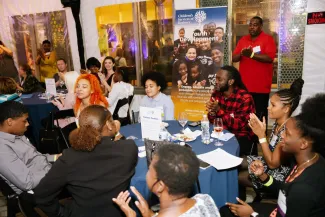Bridging the Gap: Children's Services of Roxbury Is Expanding Students' Access to Mental Health Services
If a service exists but those who need it most don’t know about it, how useful can that service be?
Not very useful, of course. Children's Services of Roxbury is doing something to change that.
Since its founding in 1972, CSR has recognized that too many families and children of every background find themselves trapped in systems they may not trust, understand, or even know of — and therefore cannot use effectively. The group’s mission is to help families build networks of professional and community supports.
The latest example of CSR’s work is Bridge to Resiliency, created with a grant from Boston Children's Collaboration for Community Health. The program is a racial equity demonstration project created in partnership with Boston Public Schools, the Massachusetts Department of Mental Health, and the Smith College School for Social Work to expand access to culturally attuned mental health services for students with multiple adverse childhood experiences.

Connecting students to programs
As Darryl Huggins, director of CSR’s Bridge to Resiliency notes, MassHealth — the state’s healthcare agency — provides a wealth of behavioral health services, and all state residents are entitled to the care they need. “But if youths don’t get connected to these services,” he says, “naturally they don’t receive them.” The Bridge to Resiliency can be thought of as glue, Huggins adds; children’s needs are identified, and CSR then connects them to appropriate programs.
Helping to apply that glue are a pair of professionals whose employment is made possible by the grant:
-
A Bridge Coordinator works closely with the six schools that are served by the program to essentially triage referrals. The Bridge Coordinator “is in each school weekly,” says Huggins. “They’re eyes and ears, listening, attending support meetings. They can immediately identify the appropriate services for that child.”
-
A Family Partner, because students’ needs don’t occur in a vacuum. This professional “sits down with the family to understand what needs they have,” Huggins says. “We may find trauma, homelessness, food insecurity.” It’s important that all service providers grasp such issues in order to get a 360-degree view of the youth.
As an example, Huggins relates a case from his own work in the field. A fourth-grader grew very detached in school, daydreaming in a way that interfered with his performance. Teachers and school officials didn’t understand why until a relationship was established with the student’s mother. “It turned out he’d seen two people in his family murdered,” Huggins says. “Once we learned that, we were able to start fixing the problem. If we couldn’t have gone in the home, we couldn’t have helped.”
Measuring progress
One of CSR’s targets for the Bridge to Resilience is to increase the number of students who make use of available services. “We’d like to get 150 kids per year enrolled in behavioral services,” Huggins says, “increasing awareness about the help that’s out there.” Additionally, the idea is to teach people to fish: “We understand we can’t do this forever,” he adds. “We want to empower families to go out and meet these needs on their own.”
